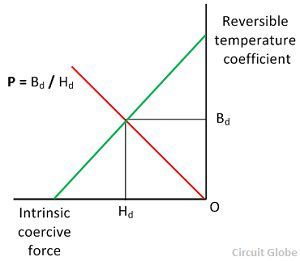Definition: It is the measure of the ease with which flux can be set up in a material. In other words, it measures the magnitude of the flux for the number of turns in an electric circuit. The permeance is analogous to the conductance in an electrical circuit.
It is given as the reciprocal of the reluctance (S) of the material in a magnetic circuit. It is denoted by P and measured in Weber per ampere turns (Wb/AT) or Henry (H). The permeance of the magnetic circuit is expressed as:
![]() Where a – cross-sectional area
Where a – cross-sectional area
l – magnetic path length
μo – permeability of vacuum
μr – permeability of air
The graph below shows the permeance coefficient curve. The permeance coefficient is used for designing the magnetic circuit. It is defined as the ratio of the magnetic flux intensity to the magnetic flux density of the demagnetizing curve. It is also known as the load or the operating point.
 The permeance coefficient is express as
The permeance coefficient is express as ![]() Where Bd – flux density of demagnetizing curve.
Where Bd – flux density of demagnetizing curve.
Hd – field intensity of demagnetizing curve.
The reversible temperature coefficient shows the relative change in the physical properties and the temperature of the ferromagnetic material. And the intrinsic coercive force measures the ability of the material to withstand, an external magnetic field.
If the material has high coercive force, then it is called the magnetically hard material, and if it has low coercive force, then it is referred to as the magnetically soft.
